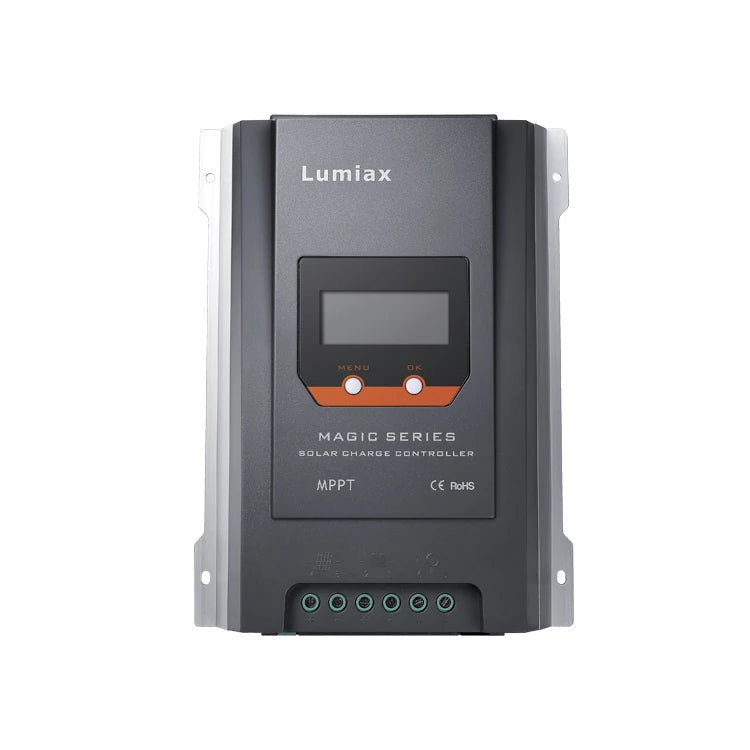
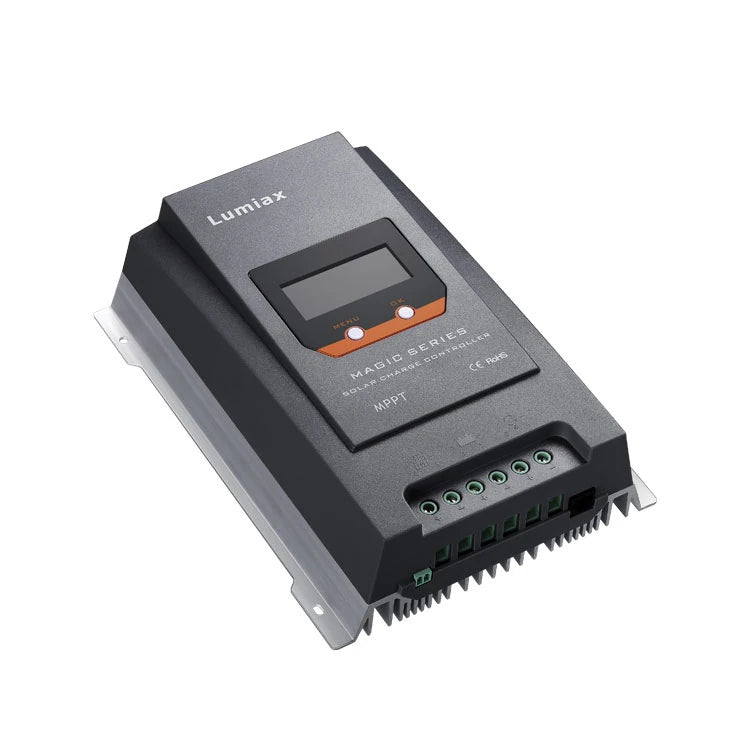
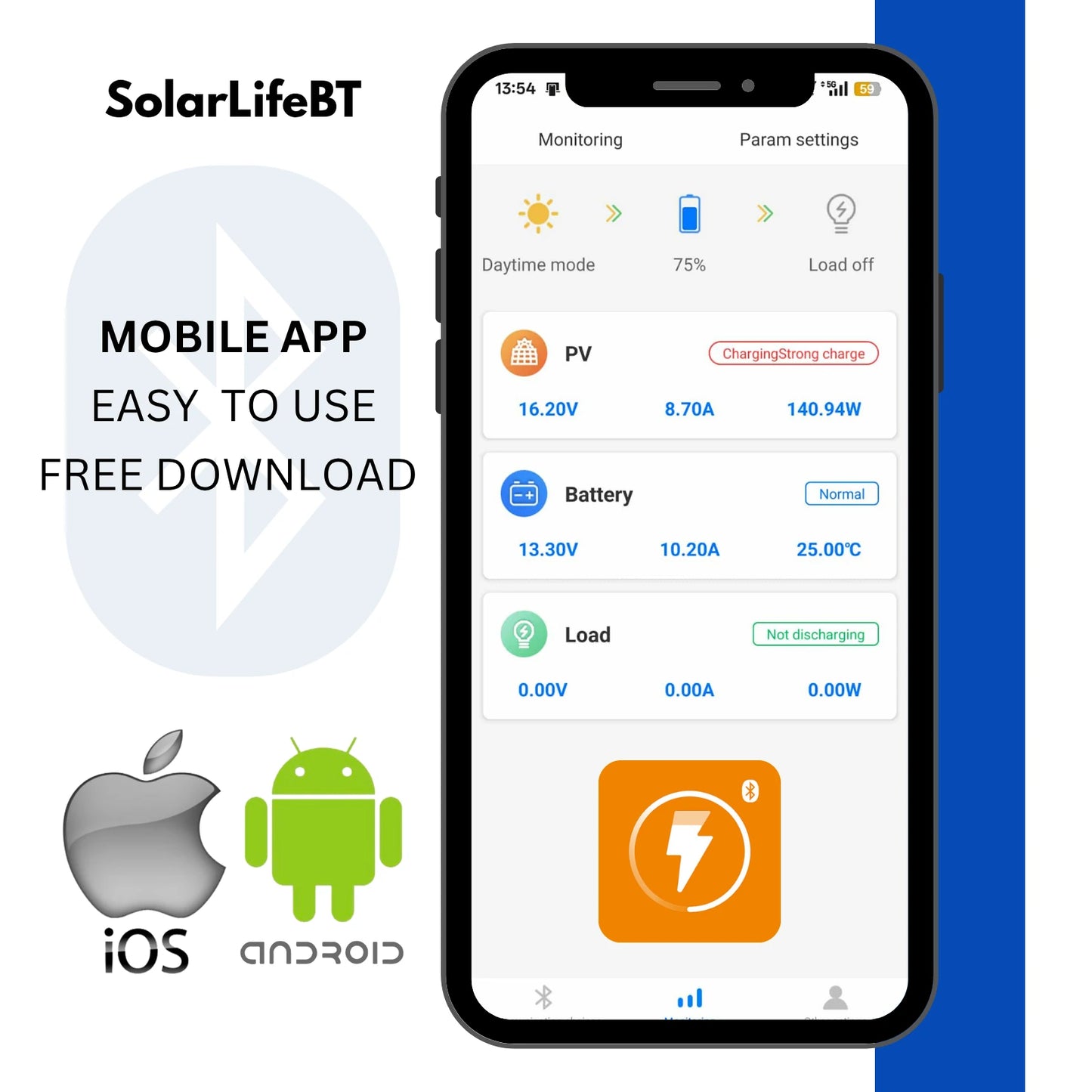
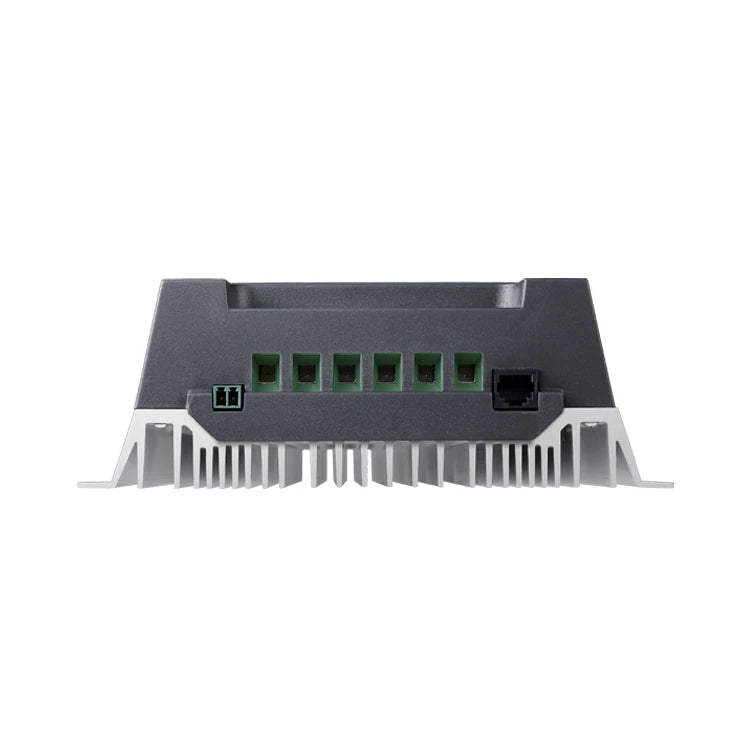
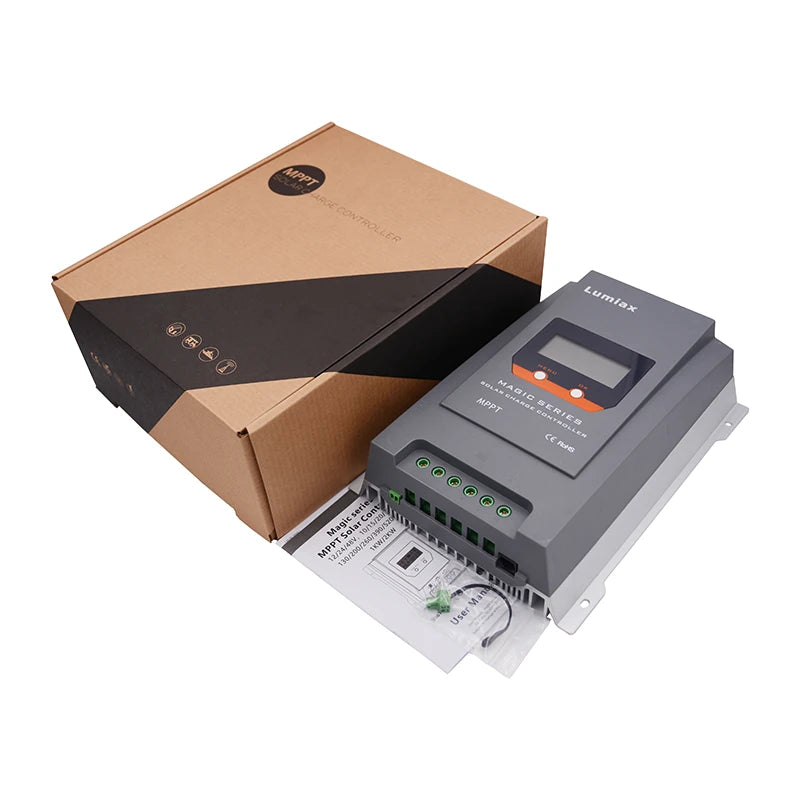
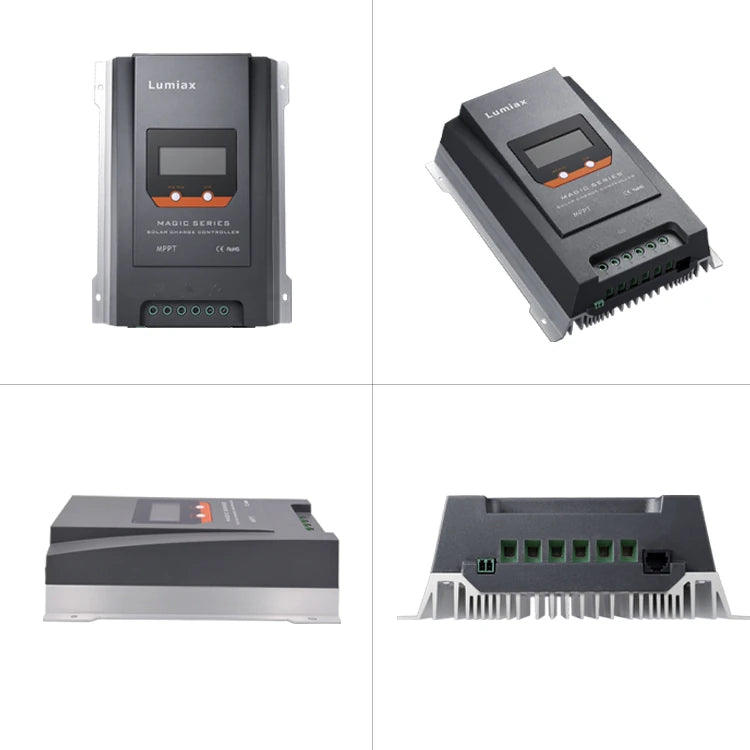
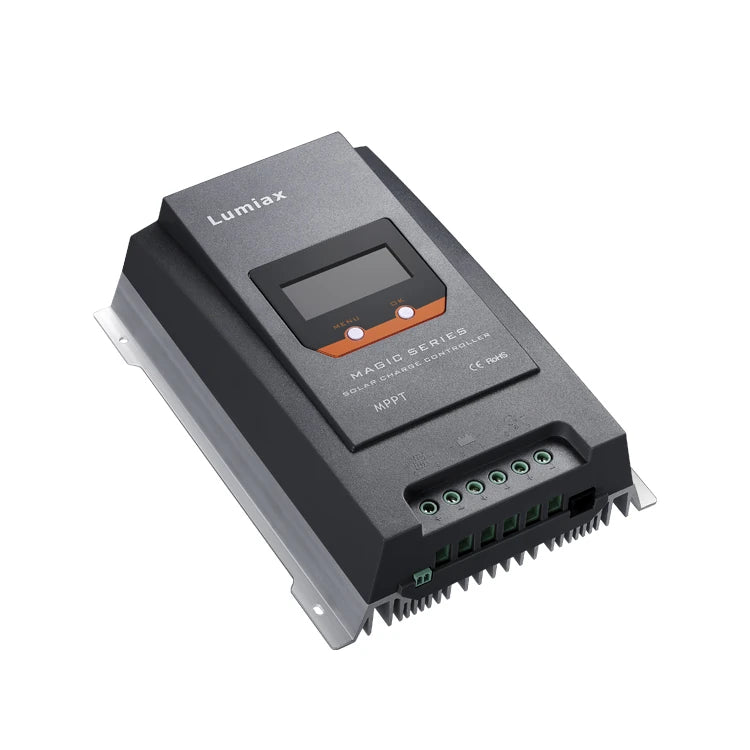
Why You’ll Love It
|
Higher Efficiency
MPPT tracking extracts up to 30% more energy than PWM—great for limited roof space and changing weather. |
|
Lithium-Ready
Optimized for LiFePO₄ and fully compatible with AGM, Gel, and Flooded lead-acid chemistries. |
|
Built-In Bluetooth
Monitor and configure from your phone with a free iOS/Android app—no external dongle required. |
|
Clear Local Display
Backlit LCD shows PV, battery, load, and charge stage at a glance. |
|
Runs Hard, Stays Cool
Oversized cast-aluminum fins deliver long run times at max power without thermal derating (with proper ventilation). |
|
Full System Protection
Safeguards against over-voltage/current, reverse polarity, short circuits, over-temperature, and low-voltage disconnect. |
Overview
Get more power from your solar array with the MT4010—a powerful 40A MPPT charge controller designed to maximize energy harvest and simplify system control. Supporting up to ~520W of PV on 12V or ~1040W on 24V (just respect Voc limits), the MT4010 is your go-to for off-grid setups, whether you’re powering a van, boat, tiny home, or cabin.
Monitor and tweak performance effortlessly using the free iOS/Android app over Bluetooth—no dongle required.
In real-world environments—cold mornings, partial shade, or shifting light conditions—MPPT delivers noticeably more usable energy than PWM, helping you squeeze more runtime from limited panel space.
Efficient, Battery-Friendly Charging
The MT4010 offers high-precision MPPT tracking (>99.9% accurate, up to ~98% efficient) to push every watt into your batteries. It supports multi-stage charging (bulk → boost → equalization → float) for lead-acid systems, and lets you fine-tune voltage targets for LiFePO₄ / Lithium chemistries—perfect with Sapphire lithium battery lines.
Expect fuller batteries, more runtime, and faster recovery even in variable temperature and weather conditions.
Smart and Simple to Use
Keep tabs on voltage, charge stage, load, and more with the easy-to-read backlit LCD or the Bluetooth app. For system integrators, RS-485 (Modbus via RJ11) offers advanced control and data access.
Automate lighting or DC equipment using the programmable load output: pick Always-on, dusk-to-dawn “street-lamp,” or custom timer modes—no extra components needed.
A great combo: pair the MT4010 with ~400–520 W of panels and a 300 Ah LiFePO₄ battery for van systems—you’ll get multi-day autonomy and high reserve capacity without upsizing your controller later.
Built for Reliability
Stay powered without slowing down. The rugged cast-aluminum heatsink allows the MT4010 to run at full capacity—even in hot climates—without thermal derating. Implement it with proper ventilation and enjoy consistent performance year-round.
Rated IP32 and armed with protections against over-voltage/current, short circuits, reverse polarity, over-temperature, low-voltage disconnect, and thermal override, it’s built tough for long-term use. M6 terminals (up to AWG 4 cable) and common-negative wiring help make installations clean and efficient.
Who It’s For
Perfect for midsize off-grid systems—from vans and RVs to sailboats, tiny cabins, job trailers, and remote IoT sites. With its robust cooling, Bluetooth control, and adaptability for different battery types, the MT4010 is designed to grow with your setup.
It’s the smart choice if you want high efficiency, reliability in all seasons, and the flexibility to expand later.
Applications
- RVs, trailers & van conversions — 12 V house systems up to ~520 W PV; Bluetooth app makes monitoring easy on the road.
- Marine (sail & power) — 12/24 V house banks with up to ~1040 W PV on 24 V; mount in a dry, ventilated locker.
- Off-grid cabins & tiny homes — daily loads like lights, fridges, pumps; multi-stage charging for LiFePO₄, AGM, Gel, Flooded.
- Remote telecom & IoT — gateways, repeaters, sensors; integrate data via RS-485 (Modbus) or use Bluetooth for quick checks.
- Security cameras & network gear — reliable DC power with programmable load modes and LVD protection.
- Solar lighting & signage — dusk-to-dawn “street-lamp” mode plus timer/user schedules.
- Field power carts & battery boxes — portable off-grid charging with real-time LCD status.
- Agriculture & ranch — fence energizers, sensors, irrigation controllers in sheltered enclosures.
- Job trailers & construction — tool charging, lighting, and comms support at temporary sites.
- Battery maintenance & backup — keep boats/vehicles topped up during storage.
Performance in Real-World Setups
 Rugged construction ensures reliable operation in all seasons — ideal for year-round off-grid power.
The MT4010’s high-speed MPPT tracks the optimal voltage/current point as light and temperature change, helping recover energy that would otherwise be lost in
partial shade, moving rigs, or cool mornings. In healthy arrays sized for the controller (e.g., ~400–600 W on 12 V; ~800–1000 W on 24 V),
it can sustain high bulk-charge currents when the battery state-of-charge and sun conditions allow.
Rugged construction ensures reliable operation in all seasons — ideal for year-round off-grid power.
The MT4010’s high-speed MPPT tracks the optimal voltage/current point as light and temperature change, helping recover energy that would otherwise be lost in
partial shade, moving rigs, or cool mornings. In healthy arrays sized for the controller (e.g., ~400–600 W on 12 V; ~800–1000 W on 24 V),
it can sustain high bulk-charge currents when the battery state-of-charge and sun conditions allow.
Thermal performance is equally practical: the controller’s oversized, cast aluminum finned heatsink sheds heat efficiently, enabling long run times at maximum power without needing to derate from overheating when installed with proper ventilation. Real-time Bluetooth monitoring makes it easy to see bulk/absorb/float transitions and verify array output, while RS-485 integration supports deeper logging and system control. Actual results vary with array orientation, wiring, ambient temperature, and site conditions.
Install & Sizing Tips
For 12 V systems, size arrays up to ~520 W; for 24 V systems, up to ~1040 W (observe the controller’s 95 V @ 25 °C / 100 V cold Voc limit). Keep wiring short and appropriately sized, and mount the controller in a sheltered, ventilated location. The MT4010’s heavy, finned aluminum body is designed to run cool at sustained output; allow airflow clearance around the heatsink.
Use the free iOS/Android app over built-in Bluetooth for quick checks and configuration, or tie into system monitors via RS-485 (Modbus). Always set charging targets per your battery manufacturer’s recommendations (especially for LiFePO₄) and confirm that the controller’s 40 A charge rate is within the battery’s allowable charge current.
Key Features
- >99.9% MPPT tracking efficiency and up to 98% conversion for maximum solar harvest
- Built-in Bluetooth — wireless monitoring & configuration via a free mobile app on iOS & Android (no dongle required)
- 40 A charging with 12/24 V auto-detection; supports up to 520 W (12 V) / 1040 W (24 V) PV input
- Optimized multi-stage charging profiles for LiFePO₄, AGM, Gel, and Flooded batteries
- Backlit LCD display for real-time system status, charge stage, and setup
- Programmable load output with modes: Always-on, Street-lamp (dusk-to-dawn), and Timer/User
- RS-485 (Modbus via RJ11) for integration and advanced data access
- Heavy-duty cast aluminum finned heatsink for sustained high-load cooling
- IP32 enclosure; operating range −20 °C to +55 °C
- Comprehensive protection: over-voltage/current, short-circuit, reverse polarity, over-temperature, LVD, and thermal derating
Engineered for Real-World Loads
The MT4010’s advanced MPPT engine continuously tracks the optimal power point of your solar array, delivering higher real-world charging performance than traditional PWM controllers—especially in changing light, partial shade, or cooler temperatures where panel voltage varies.
With multi-stage charging tuned for modern LiFePO₄ packs (and fully compatible with AGM, Gel, and Flooded batteries), the MT4010 maximizes usable capacity while protecting your investment. Its backlit LCD keeps key metrics visible at a glance, and smart load modes automate lighting and DC outputs.
Built for sustained output, the MT4010 pairs its power electronics with an oversized, cast aluminum finned heatsink that keeps temperatures in check—delivering long run times at maximum power without needing to derate from overheating. Use the free iOS/Android app over Bluetooth for wireless monitoring and setup, or integrate via RS-485 (Modbus) for deeper system control. A rugged IP32 enclosure makes it a reliable choice for vans, cabins, boats, and remote sites.
Technical Specifications — MT4010
| System | |
| Model | MT4010 |
| Technology | MPPT |
| System Voltage | 12 V / 24 V (automatic recognition) |
| Max Charging Current | 40 A (0-40A Adjustable via App) |
| Max Battery Voltage | 35 V |
| Battery Types | Gel, AGM, Flooded (Liquid), LiFePO₄ / Lithium |
| Self-Consumption | ≤ 8 mA (12 V) · ≤ 12 mA (24 V) |
| Solar PV Input | |
| Max PV Input Power | 520 W (12 V system) · 1040 W (24 V system) |
| Max PV Voltage (Voc) | 100 V @ −20 °C · 95 V @ 25 °C |
| MPPT Tracking Range | (Battery Voltage + 1.0 V) → 0.9 × Voc |
| Charging Performance | |
| MPPT Tracking Efficiency | > 99.9 % |
| Charge Conversion Efficiency | Up to 98 % |
| Charging Algorithm | MPPT → Boost → Equalization → Float |
| Lead-acid Voltages @25 °C | Boost 14.0–14.8 V · Equalize 14.0–15.0 V · Float 13.0–14.5 V |
| LVD / Reconnect |
Lead-acid: 10.8–11.8 V / 11.4–12.8 V (12 V system) Lithium: 9.0–30.0 V / 9.6–31.0 V |
| Temperature Compensation | −4.17 mV/K/cell (Boost/Equalize) · −3.33 mV/K/cell (Float) |
| Protection Functions | Over-voltage, over-current, short-circuit, reverse polarity, over-temperature, load disconnect, thermal derating |
| Outputs & Interface | |
| Load Output | 20 A max |
| Load Output Modes | Always-on / Street-lamp / Timer / User-defined |
| USB | N/A |
| Display | Backlit LCD (text, icons, real-time values) |
| Communication | Built-in Bluetooth (free mobile app on iOS & Android) · RS-485 (Modbus via RJ11) |
| Physical & Environmental | |
| Dimensions | 255 × 189 × 69 mm · 10.0 × 7.4 × 2.7 in (rounded to nearest 0.1") |
| Weight | ~ 2 kg (4.4 lb) |
| Terminals | M6 · up to 25 mm² cable (AWG 4) |
| Case Material | High-strength aluminum alloy body with heat-dissipating fins |
| Heatsink | Cast Aluminum Finned, Heavy Duty |
| Mounting | Wall-mount (vertical; maintain clearance for cooling) |
| Protection Degree | IP32 |
| Operating Temp | −20 °C → +55 °C (storage −25 °C → +80 °C) |
| Humidity / Altitude | 0–100 % RH (non-condensing) · up to 4000 m |
Solar FAQ
About Solar Charge Controllers
What does a solar charge controller do?
It prevents overcharging, regulates voltage, and ensures your battery bank charges in a safe, controlled way. Without one, solar panels could damage a battery by pushing in unregulated power.
At Sapphire, controllers are chosen to match our LiFePO₄ batteries perfectly, so you get maximum performance and lifespan from all of your gear.
What is the difference between MPPT and PWM?
This works ok for lower voltage arrays, but wastes a significant amount of energy on higher voltage panels, and potentially risks damage to control circuits on the batteries. PWM is lower cost, but lower efficiency.
MPPT (Maximum Power Point Tracking) controllers do exactly what the name implies. They use advanced electronics and actively adjust their behavior to pull the most power possible from your PV array. This is accomplished by actually transforming the excess voltage, into current that can be funneled directly into your battery system.
This boosts efficiency by up to 30%, and makes higher voltage arrays possible, reducing wiring costs. MPPT is almost always worth it. See our blog posts for deeper dives into MPPT vs PWM.
How do I size a solar charge controller?
View our Solar Panels and Charge Controllers
Can I use a solar charge controller with LiFePO₄ batteries?
Many modern controllers include lithium charging profiles built in.
How much solar can I connect to my controller?
Moderate oversizing is fine—the controller will “clip” excess power—but never exceed its voltage rating. Check the Voc ratings on your panels, and be aware that colder temperatures will increase the panel output voltage. Leave yourself a margin so you're not stressing your controller.
When in doubt, it's always better to have a controller that is rated for more than you're connecting. It will help the controller run cooler, longer.
Do I need an inverter with a solar charge controller?
The solar controller's job is to manage DC charging only. What you do with that newly charged battery power is up to you.
To power AC appliances like microwaves, laptops, or TVs, you’ll need an inverter.
Can I mix different solar panels with one controller?
Best practice is to use matched panels.
What protections are built into solar charge controllers?
Are solar charge controllers waterproof?
Some of our RV controllers are IP54 giving you excellent dust and water protections, and there are IP65 models available for fully outdoor installations.
Generally though, it's best practice to mount the controllers inside a clean, cool, dry space. If you're note sure, contact us and we're happy to help.
What accessories should I use with my controller?
Sapphire offers disconnect switches and accessories designed to work with our batteries and controllers.
How long does a solar charge controller last?
Our MPPT units are designed for long-term reliability to match the service life of our Solar Panels, and our LiFePO₄ batteries.
What are common applications?
Controllers are commonly used in van builds, RVs, cabins, boats, tiny homes, and emergency backup power kits. They’re also great for specialized uses like powering security cameras or farm gates.
See our Blog Articles for ideas and more information
About Solar Panels
What size solar panel do I need?
Start with discovering your daily power needs, cross checked with your battery sizing. See our article about sizing your battery for a good place to get started.
Can I connect multiple solar panels together?
Be sure to consider the limitations of your charge controller when adding more solar.
What happens if I oversize or undersize my solar array?
Under sizing will leave batteries undercharged, and you may struggle to keep the lights on. This may require you to augment your battery charging with things like DC-DC Engine Charging, Shore Power, or a generator.
What is the difference between monocrystalline and polycrystalline panels?
Polycrystalline panels are sometimes slightly cheaper, but are an obsolete technology and it is recommended to avoid new installs using these.
Do solar panels work in cloudy weather or winter?
MPPT controllers can help maximize energy, even in sub-optimal conditions. Many people will "over panel" when they expect low production.
How long do solar panels last?
Are solar panels waterproof and durable?
What maintenance do solar panels need?
When washing, use a non abrasive brush/cloth and a gentle soap.
Use a soft edged brush, or wiper, to remove snow and ice. Avoid hitting/impacts or using heat.
Can I install solar panels myself?
What angle or direction should solar panels face?
Flat mounting on vans and RVs works too, but expect lower winter performance. Tilting mounts can boost output, but require you to stow the panels before moving.
Buying & System Design
How do I calculate how much solar I need?
Ideally, you want to have more solar than you use in a day, so you can "catch up" after a couple of cloudy days.
For help, see our off-grid battery sizing guide.
What size battery bank should I pair with my solar panels?
Figure out your daily usage, then multiply for the number of days you want to run without charging.
After that it's just a matter of picking your batteries out. Our batteries are listed with their Watt hour (Wh) capacities to help make this easier.
See our article on battery sizing to help get a better understanding.
Do I need both a solar charge controller and an inverter?
The inverter converts DC to AC so you can run household devices. Off-grid systems use multiple components together: Solar panels + MPPT controller + Sapphire LiFePO₄ battery + Inverter.
What safety equipment do I need for a solar setup?
Sapphire carries battery disconnect switches and wiring accessories tested to handle high current safely.
Can solar power run my entire house or RV?
Reach out to us with your goals and we can help guide you!
What solar setup is best for vans, cabins, or sheds?
Vans: Usually 100–400W of panels + 100–300Ah LiFePO₄ battery.
Cabins: 400–1000W panels + 200–600Ah battery.
Sheds: 100–200W with 100Ah battery (more if you want to run tools)








